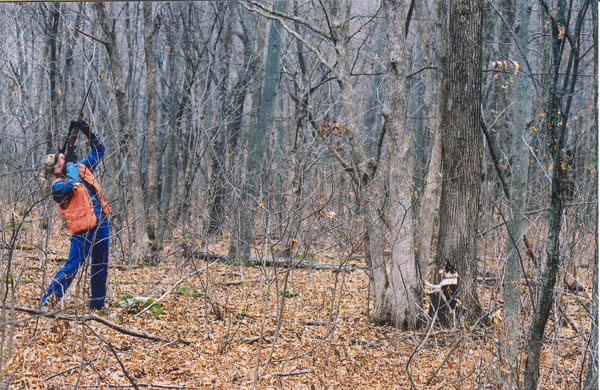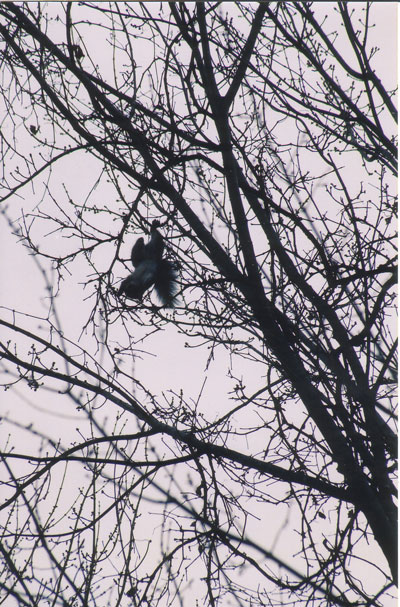Squirrel Dog Keeps Going and Going In Wisconsin Oaks
By Dick Ellis
 The urgent call of the rat terrier somewhere in the distance pulled Terry Mihlbauer up the sloping oak forest and over a barb-wire fence to the lone hickory standing guard over a patented LaValle landscape. Down the fence line, the open hillside melted away into a valley checker boarded with the browns and greens of harvested farm fields resting and waiting now for the spring plows. Then climbed again in the distance to another oak-shrouded bluff.
The urgent call of the rat terrier somewhere in the distance pulled Terry Mihlbauer up the sloping oak forest and over a barb-wire fence to the lone hickory standing guard over a patented LaValle landscape. Down the fence line, the open hillside melted away into a valley checker boarded with the browns and greens of harvested farm fields resting and waiting now for the spring plows. Then climbed again in the distance to another oak-shrouded bluff.
At the base of the hickory sat Mo, a southern-bred squirrel dog bringing a whole load of forest gumption to the northern oaks. And a full dose of trouble to Wisconsin’s gray squirrel.
“He’s up this tree, for sure” Mo seemed to yelp at Mihlbauer even as the master’s keen surveillance of the hickory showed no hint of bushy tail or wisp of moving gray. “I believe you, Boy,” Mihlbauer answered in turn. “I believe you.”
And trust he should. On three occasions, Mo had sounded off in the oak woods over the previous 30 minutes. A first gray squirrel had “timbered” tree to tree to tree to finally escape into a hole near the forest floor. The next two squirrels were now in the game bag with .22-long rifle rounds placed just behind the shoulder from Mihlbauer’s
Precisely-sighted, 35-yer old German-made Anchutz.
“When Mo barks, I’m 99 percent sure there’s a squirrel in the tree where I find him waiting,” he said. “But I didn’t always believe him. It wasn’t until I started hunting more with partners that we could see how many squirrels were hiding in the trees.”
Hunting with squirrel dogs, according to Mihlbauer, is an immensely popular tactic in southern states and north through Indiana to central Illinois. The sport is gaining more and more participants in northern regions of the country, including Iowa and Wisconsin.
Mihlbauer, a LaValle native and lifelong resident of Sauk County with the exception of his college years at UW-Madison, was introduced to hunting coons with dogs by his father and uncle as a five-year old. Squirrel hunting with dogs also was a family tradition with roots to yesteryear.
Mihlbauer continued coon hunting and still owns a Blue Tic today. Eight years ago, he decided to get back into squirrel hunting more seriously and purchased a Feist in Mondovi, Wisconsin. That dog had previously been purchased in Illinois.
“I hunted squirrels with that dog with a couple boys from Oxford,” he said. “Those boys just loved that dog. Eventually, I gave the dog to them.”
In the late 1990s, Mihlbauer traveled south to Texas specifically to buy a squirrel dog. He ended up in Arkansas, where he purchased Mo, a rat terrier of just 13 pounds, and Patches, a one-half Feist, one-half Finish Spitz female. According to internet information, other popular squirrel dogs include Mountain Curs, Jack Russell Terriers, and even Newfoundlands.
Since their return to Wisconsin, Patches has taken up residence as the Mihlbauer house dog. Mo has continued to earn his keep in the oak and hickory forests as the first leg of a hide-and-seek tag-team tandem that often ends with Mihlbauer’s knock-out punch.
The tactic is a simple one. The dog is released upon entering the woods to search out a squirrel, at times roaming hundreds of yards ahead of the hunter. Without a “cold tracking” nose that allows some dogs to shadow a coon or squirrel long after the animal has frequented an area, if Mo lets loose with his “got one going boss”call, Mihlbauer is certain the track is relatively fresh. The hunter then hurries forward with high expectations.
Supplementing his sense of smell, once located Mo uses his vision to stay with a squirrel working the tree-tops. In the case of the “timbering” squirrel that started our hunt December 19, Mo moved to the base of four different trees, sat, and spouted off to let Mihlbauer know exactly what was happening.
Upon arrival at the scene, Mihlbauer waits patently for a good shot, often using a tree to steady his aim with the scoped rifle to ensure a quick kill. As often, no shot at all concludes the chase as the squirrel escapes into a tree hole or nest.
Mihlbauer couldn’t care less. It’s the chase, after all, that brings a hunter back again. And Mo, apparently, with one-part Energizer Rabbit to blend with southern heritage and 13-pounds of heart, shares the sentiment. Regardless of each outcome of each individual chase, he just keeps going and going and….
“For me, the hunt has always been about running the dogs,” Mihlbauer said as he prepared two squirrels for a future meal. “I coon hunted for so long. These squirrel dogs do the same thing, but they do it in the daytime. If this was just about killing a lot of squirrels, I would just sit here and wait. This is about me and Mo. Just working together.”
Wisconsin Squirrel Hunting Declines With Habitat
According to Wildlife Biologist Pat Beringer of Lacrosse, surveys returned by small game hunters following the 2001 season showed that 85,000 Wisconsin hunters invested approximately 500,000 days  last year to harvest 600,000 squirrels. Squirrel hunting, he said, like small game hunting in general, has consistently declined over the last two decades.
last year to harvest 600,000 squirrels. Squirrel hunting, he said, like small game hunting in general, has consistently declined over the last two decades.
“The last couple of years there have been a slight increase in squirrel hunting, but overall the trend is down,” said Beringer, whose own family hunting heritage included hunting squirrels and rabbits with bow and arrow, and mom’s squirrel casserole. “Today, time is more limited and hunters often have to choose which sport they will participate in. They often choose deer hunting. We’re kind of losing our tradition of squirrel hunting.”
Gray and Fox squirrels, he said, are hunted for food. Gray squirrels also often have black fur, particularly in city environments for no known reason and blond phases. According to an internet article entitled, “Wisconsin Gray and Fox Squirrels”, both species are tree-bearing although grays spend most of their time on the ground. Fox squirrels average between 20 and 22 inches in length and weigh 24-32 ounces. Gray squirrels average between 18 and 21 inches and weigh between 16 and 28 ounces.
Squirrels mate in January and February, and again for three months beginning in May. Males pursue several mates, but defend each of those mates from competing males. Squirrels make nests or homes in holes in trees 25 to 30 feet of the ground, with young borne after a 40 to 44 day gestation period. A gray squirrel litter will be from two to five young. Fox squirrel offspring will number one to six.
Squirrel communities are set within the forests that provide food. According to Beringer, primary diet includes oak, hickory, and walnut. A gray squirrel will stay within a 1000 foot area, and often within a 500 foot area. Fox squirrels’ home range will be within a 40-acre area, and is often restricted to ten acres.
“It’s good to have multiple food sources in the area,” he said. “If the hickory nut crop is down one year chances are that the acorn crop is up. Different forestry practices in recent years that include big tree management should also bring back more habitat for squirrels. It’s not just timber for money today.”
Loss of habitat through burning and cutting precipitated a major decline in the Wisconsin squirrel population shortly after early settlers found huge populations. So many of the critters inhabited the state in fact, according to the internet, that some communities paid bounties on squirrels to protect crops.
In addition to incisor teeth to open those tasty nuts, and special tactile hairs to help them find their way in dark tree holes and crevices, squirrels have keen eye-sight to guard against intruders. There are many.
In addition to man, squirrels are preyed on by coyote, fox, bobcat, birds of prey, domestic cats, and even raccoons. Even with an average harvest of 1.5 million squirrels during hunting seasons of recent decades from an estimated Wisconsin population of 8 million, only fox squirrel numbers seem periodically affected by hunting pressure. Perhaps, according to the internet, because of this species “strictly diurnal” (daytime) activity.
“Look up,” states the internet article in recommending hunting tactics,” If you see red or white oak or hickory trees, you will see squirrels. Or very soon you will see squirrels. Hunt ridge tops and shoot at fruit-bearing limbs that are now even with you. You’ll be amazed at how many squirrels you see.”
Because of the relatively small areas inhabited by squirrels, find a hotspot and that area will produce good hunting year after year. Popular tactics include sitting and stalking. A less popular Wisconsin tactic very popular in more southern states is to hunt with squirrel dogs.
Stalkers, often choosing small gauge shotguns with tight chokes, move slowly through the woods listening for leaves on the ground rustling, tree limbs shaking, empty nut hulls hitting the forest floor, and most importantly, squirrel barks. Sitters, often with .22-caliber rifles or more recently, black-powder rifles, simply wait in ambush on the forest floor for squirrels to appear. A bit more strategy to the sitter’s hunt can be added by using a distress call.
The whistle-type call imitates a young squirrel in trouble, which angers the adults into investigating the problem. The hunter blows the call, then settles in to wait quietly until the adult exposes itself to the shot. Sitters are encouraged not to retrieve a dead squirrel because the animals’ curiosity often enables the hunter to take several squirrels from one community before moving on.
From the perspective of Wildlife Biologist Beringer, sitting and ambushing squirrels is among the very best ways to introduce kids to the sport of hunting in general.
“It’s a great opportunity to bring youth hunters in,” he said. “You hunt together. You show the young hunter the importance of sitting still and ethics, and you teach the hunter what the squirrel feeds on in its own environment. It’s akin to bluegill fishing. They will get action, and that will peak the kids’ interest.”







